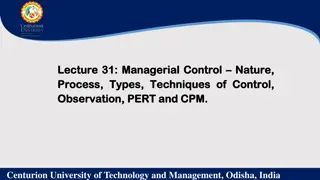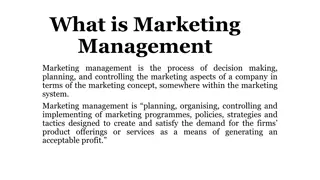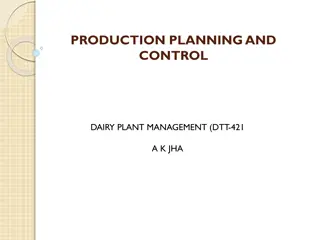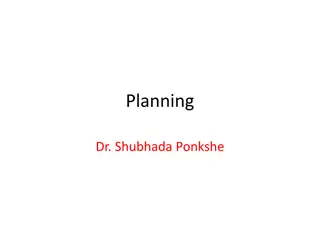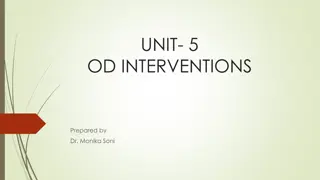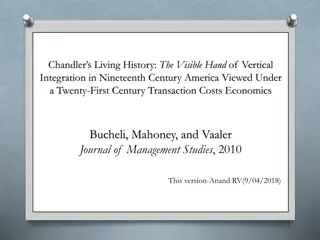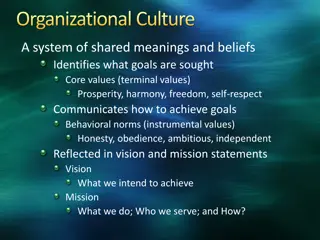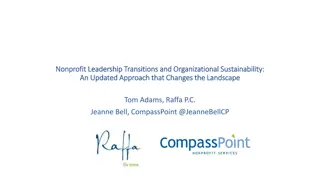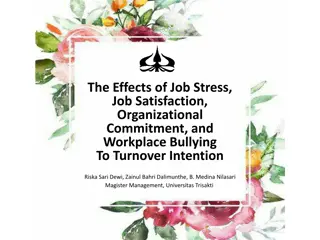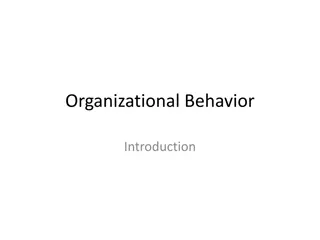Understanding Planning and Control in Organizational Management
Explore the key concepts of planning and control in organizational management, including lateral links, connection mechanisms, output standardization, performance evaluation, action planning, and decision-making processes. Learn how planning specifies outputs in terms of quantity, quality, cost, and time, while control evaluates if objectives have been achieved. Gain insights into improving profit rates, defining actions, and enhancing performance through effective control mechanisms.
Download Presentation

Please find below an Image/Link to download the presentation.
The content on the website is provided AS IS for your information and personal use only. It may not be sold, licensed, or shared on other websites without obtaining consent from the author. Download presentation by click this link. If you encounter any issues during the download, it is possible that the publisher has removed the file from their server.
E N D
Presentation Transcript
LATERAL LINKS LATERAL LINKS Martina Dal Molin mdalmolin@liuc.it AY 2016/2017
Agenda Agenda Introduction Planning and control oPerformance control oAction planning Connection mechanisms 2
Introduction Introduction Lateral links Connection mechanisms Planning and control Mutual adjustment Output standardization 3
PLANNING AND CONTROL PLANNING AND CONTROL AA 2015/2016
Planning.. Planning .. Planning Is the specification of an output at t + 1 The output is specified in terms of: oQuantity oQuality oCost oTime Examples: oBudget, program, objectives, operational plan 5
.. And control .. And control Control Is the evaluation if the objective has been achieved The output is evaluated in terms of: oQuantity oQuality oCost oTime 6
Planning and control (1/2) Planning and control (1/2) There are two types of planning and control: Performance evaluation oEx-post results evaluation Profit rate should be improved from 7% to 10% Manolo Blahnik Green has to be be sold to young and old women Action planning oAction are defined before 7
Planning and control (2/2) Planning and control (2/2) ACTION PLANNING DECISION 2 DECISION 3 DECISION 1 DECISION 4 DECISION 5 DECISION 6 DECISION n ACTION 2 ACTION 3 ACTION 1 ACTION 5 ACTION 6 ACTION 4 ACTION n PERFORMANCE CONTROL 8
Performance control (1/2) Performance control (1/2) Performance control has the objective of controlling the results of an organizational units In June 2016 200 pairs of Manolo Blahnik should be produced 9
Performance control (1/2) Performance control (1/2) Obj, budget, operational plans are defined for each units OVERLAPPING WITH GROUPING Units performance is controlled and evaluated according to the defined standard RELEVANT IN UNITS GROUPED ON THE MARKET RESULS ARE EVALUATED WITH RESPECT TO TIME AND TO IN RELATION WITH SPECIFIC DECISION OR ACTION Performance results are transferred to the strategic apex 10
Performance control: Performance control: finalities finalities EVALUATION To identify lower performances and to introduce corrective actions To support and encourage better performances MOTIVATION, problems: Tendency to define low performance standards Problem of when to plan Sometimes performance standards are not achieved for external and contextual reasons 11
Actions Actions planning (1/2) planning (1/2) Planning actions means taking a specific decision that is related to (a set of) specific actions Stop producing blu Manolo Blahnik. Start production of Emerald one 12
Actions Actions planning (2/2) planning (2/2) Examples of action planning: o New product o Building new plant o Sell old machinery It does not respect the autonomy of organizational unit Decision could also be inter-unit Since it is based on specific decision, action planning isn t a proper standardization of output FORMALIZATION of BEHAVIOUR PERFORMANCE CONTROL ACTION PLANNING High regulation Low regulation 13
Performance control and Performance control and action action planning planning ACTION PLANNING The strategic apex defines the organizational strategy PERFORMANCE CONTROL The strategic apex defines obj, bdg, These obj are articulated in sub- obj in the form of operational plan (top-down) OR Obj are proposed by the operating core to the strategic apex (botto-up) The strategy is translated in decision Decision are translated into actions (top-down process) 14
Find Find performance control performance control 15
Find Find action action planning planning 16
CONNECTION MECHANISMS CONNECTION MECHANISMS AA 2015/2016
Connection Connection mechanisms mechanisms Connection mechanisms have the objective of favoring mutual adjustment with the final aim of regulating interdependencies that could not the controlled through direct supervision and standardization John Kenneth Galbraith (1973) identified a continuum of four connection mechanisms: oliason positions oTask forces and committees oIntegration managers oMatrix structure 18
Liason Liason positions positions They are used to to: oCoordinate the activities of two units oFavor the direct flow of information No formal authority, but informal power Power is related to information, not to the formal position They could be created: oBetween different line units Engineering and production, engineering and purchase oBetween line and staff units HR and and accounting 19
Task Task forces forces and and commitees commitees Focus on meetings, that favor mutual adjustment Informal meeting Formal and institutionalized meeting oi.e. meetings that are regularly scheduled oi.e. meeting that are art of the formal organization Meetings are institutionalized throguh two channels: oTasks forces, i.e. temporary committee with a specific task oCommittee, i.e. interunit committee that organizes regular meeting to dicuss specific problems 20
Integration Integration managers managers Liason position with formal authority Formal power is related to the decision making process, not to people Formal power is related to: oPower to approve decision (e.g. to approve the budget) o Previsional power with respect to decision (e.g. definition of the budget that in approved by units) oPower to control the decision-making process (e.g. the managers gives resources to units according to their results) Examples: oProduct managers oProject managers oProgram managers 21
Matrix Matrix structure structure Starting point: no grouping basis is able to manage all the interdependencies We know that organizations can solve the problem by adopting one of the following three configuration: oHierarchical structure oLine and staff structure oStructure with connection mechanisms 22
Hierarchical Hierarchical structure structure 23
Line and staff Line and staff structure structure 24
Line and staff Line and staff structure structure 25
Structure Structure with connection with connection mechanisms mechanisms 26
Matrix Matrix structure structure oHierarchical structure oLine and staff structure oStructure with connection mechanisms They all privilege one grouping basis compared to others. Sometimes it is necessary to combine different configurations (e.g. market and product, geopgraphical location and output) Matrix structure 27
Matrix Matrix structure structure (1/2) (1/2) The principle of uniqueness of command is not satisfied Formal authority is divided and it creates joint responsibilities Differen managers are equally responsible for the same decision Managers must manage divergencies by creating an internal equilibrium 28
Connection Connection mechanisms mechanisms? ? 29




